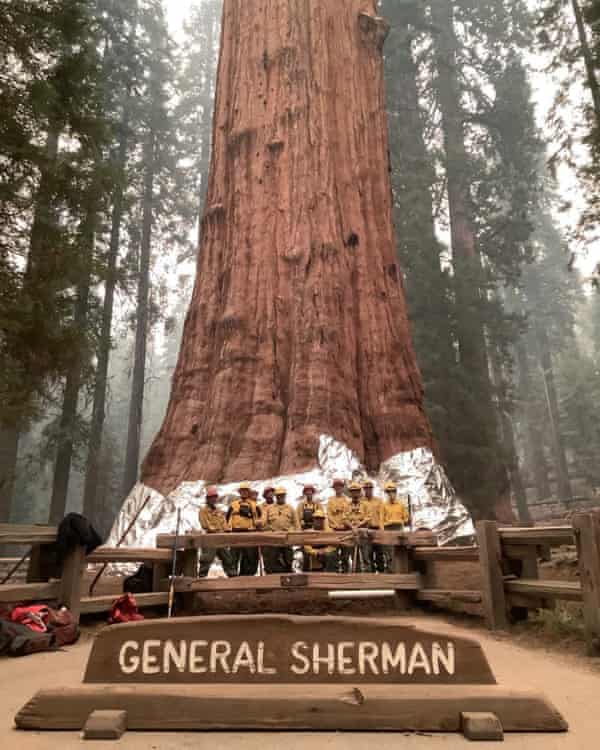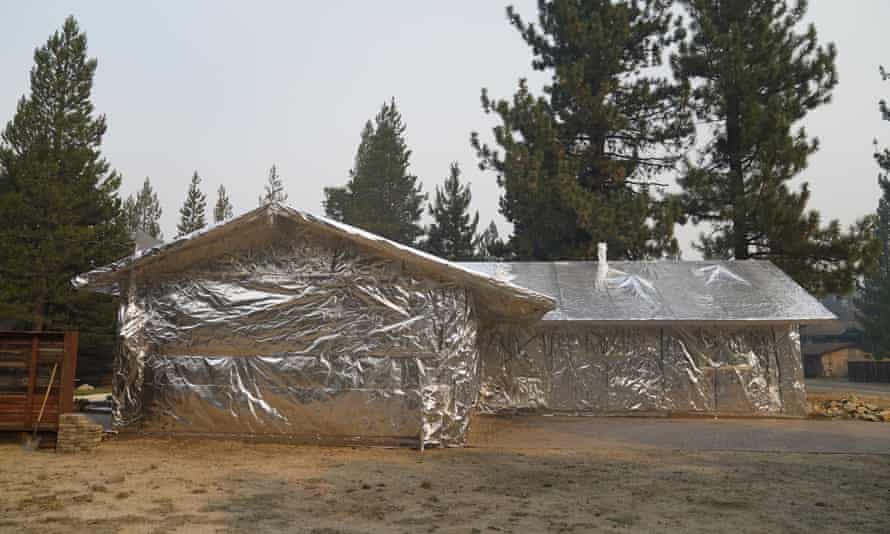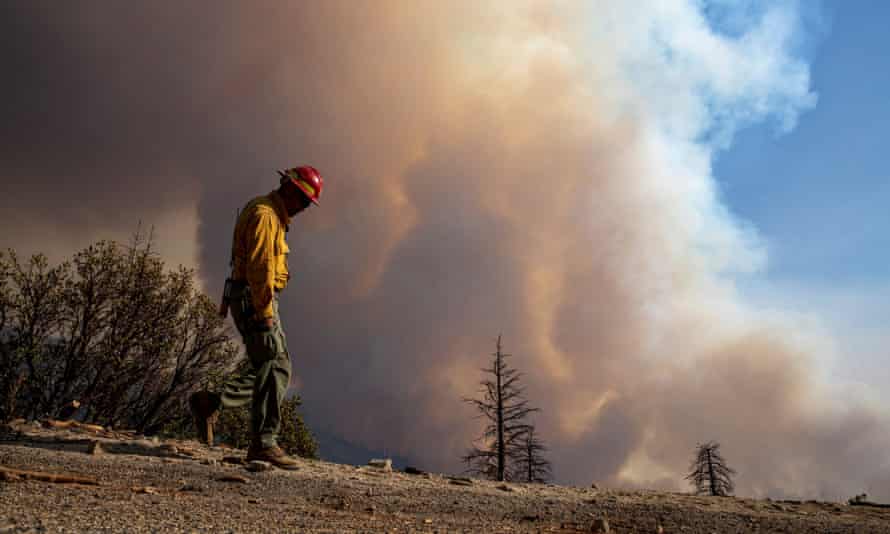Extract from The Guardian
National Weather Service issues weather watch for critical fire conditions in Sequoia national park.
Wildfires in California threaten world's biggest tree – video
First published on Sun 19 Sep 2021 00.04 AEST
Crews continue to battle California wildfires that have burned into some groves of ancient giant sequoias, the world’s largest tree.
The National Weather Service (NWS) issued a weather watch for critical fire conditions in the Sequoia national park in the Sierra Nevada, where the Colony fire was burning about a mile from Giant Forest, a grove of 2,000 sequoias.
Firefighters wrapped the base of the General Sherman Tree in fire-resistant aluminum of the type used in wildland firefighter emergency shelters and to protect historic wooden buildings, fire spokeswoman Rebecca Paterson said.

Firefighters pose next to the General Sherman Tree after wrapping it in fire-resistant blanket on 17 September. Photograph: National Park Service/EPA
The General Sherman Tree is the largest in the world by volume, at 52,508 cubic ft, (1486 cubic m) according to the National Park Service. It is 275ft (83m) high and has a circumference of 103ft (31m) at ground level.
Some Californians are choosing to wrap their homes in the fire-resistant aluminum. One wrapped home near Lake Tahoe survived the Caldor fire while neighboring houses were destroyed.
The wrapping deflects heat, helping prevent flammable materials from combusting. It also keeps airborne embers, a major contributor to spreading wildfires, from slipping through vents and other openings. With a fiberglass backing and acrylic adhesive, the wraps can withstand heat of up to 1,022 F, or 550C.
The current fires are eating through tinder-dry timber, grass and brush. Historic drought tied to climate change is making wildfires harder to fight. It has killed millions of trees in California alone. Scientists say climate change has made the west much warmer and drier in the past 30 years and will continue to make weather more extreme and wildfires more frequent and destructive.
The Colony fire is one of two lightning-caused blazes, known together as the KNP Complex, that have burned about 18 square miles of forest.
The fires forced the evacuation of the park and parts of Three Rivers, a community of about 2,500 people outside the park’s main entrance. Crews have been bulldozing a line between the fire and the community.
Cooler, calmer weather and morning low-hanging smoke that choked off air limited the fire’s growth in recent days but the NWS said a low-pressure system will bring some gusty winds and lower humidity through Sunday in the fire area. However, fire officials weren’t expecting the kinds of explosive wind-driven growth that in recent months turned Sierra Nevada blazes into monsters that devoured hundreds of homes.

A home is completely wrapped in fire-resistant material in Meyers, California. Photograph: Jae C Hong/AP
“There isn’t a lot of extreme weather predicted for the next few days, which is good news, there’s not a lot of big wind shifts predicted. However, there’s also no rain predicted,” fire information spokeswoman Rebecca Paterson said. “So we’re anticipating that the fires are going to continue to grow. Hopefully they’re not going to grow too fast.”
The fires have burned into several groves containing trees as tall as 200ft and 2,000 years old. They include Oriole Lake grove in the national park and Peyrone North and South groves in the neighboring Sequoia national forest.
The fire had reached Long Meadow grove in the national forest, where two decades ago Bill Clinton signed a proclamation establishing a national monument.
“These groves are just as impressive and just as ecologically important to the forest,” Tim Borden, who is sequoia restoration and stewardship manager for the Save the Redwoods League, told the Bay Area News Group. “They just aren’t as well known. My heart sinks when I think about it.”

A fire crew member keeps an eye on a hillside as flames roil the Sequoia national forest on 16 September. Photograph: Brian van der Brug/Los Angeles Times/REX/Shutterstock
To the south, the Windy fire grew to nearly 11 square miles on the Tule River Indian Reservation and in Giant Sequoia national monument, where it has burned into one grove of sequoias and threatens others.
Fire officials haven’t yet been able to determine how much damage was done to the groves, which are in remote and hard-to-reach areas.
Last year, the Castle fire killed an estimated 7,500 to 10,600 large sequoias, according to the National Park Service. That was an estimated 10% to 14% of all the sequoias in the world.
No comments:
Post a Comment